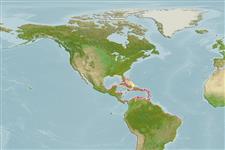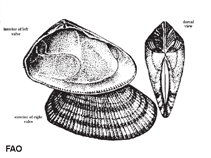Donax denticulatus Linnaeus, 1758
Common Caribbean Donax| Native range | All suitable habitat | Point map | Year 2050 |

|
| This map was computer-generated and has not yet been reviewed. |
| Donax denticulatus AquaMaps Data sources: GBIF OBIS |
Classification / Names Common names | Synonyms | CoL | ITIS | WoRMS
Bivalvia | Cardiida | Donacidae
Environment: milieu / climate zone / depth range / distribution range Ecology
Benthic; depth range 0 - 1 m (Ref. 83435). Tropical
Distribution Countries | FAO areas | Ecosystems | Occurrences | Introductions
Western Atlantic: Caribbean to Brazil.
Length at first maturity / Size / Weight / Age
Maturity: Lm ? range ? - ? cm Max length : 1.8 cm DL male/unsexed; (Ref. 83435); common length : 2.5 cm TL male/unsexed; (Ref. 344); max. reported age: 2.00 years (Ref. 8702)
Short description Morphology
Shell wedge-shaped, inflated. Posterior slope with 2 curved ridges. Surface sculpture consisting of fine radial grooves of microscopic pinpoints. Colour: variable, usually brown, yellowish or purple, with rays of darker hues (Ref. 344).
Assumed total length is 2.5 cm (Ref. 344). Maximum depth from Ref. 104365. Found on beach and shoreline (Ref. 104365). Infaunal in shallow sand, usually in environments rich in particulate organic matter (Ref. 344).
Life cycle and mating behavior Maturity | Reproduction | Spawning | Eggs | Fecundity | Larvae
Members of the class Bivalvia are mostly gonochoric, some are protandric hermaphrodites. Life cycle: Embryos develop into free-swimming trocophore larvae, succeeded by the bivalve veliger, resembling a miniature clam.
Main reference
References | Coordinator | Collaborators
Leal, J.H. 2003. (Ref. 344)
IUCN Red List Status (Ref. 130435)
CITES status (Ref. 108899)
Not Evaluated
CMS (Ref. 116361)
Not Evaluated
Threat to humans
Human uses
| FishSource |
Tools
More information
Internet sources
BHL | BOLD Systems | CISTI | DiscoverLife | FAO(Publication : search) | Fishipedia | GenBank (genome, nucleotide) | GloBI | Gomexsi | Google Books | Google Scholar | Google | PubMed | Tree of Life | Wikipedia (Go, Search) | Zoological Record
Estimates based on models
Preferred temperature
(Ref. 115969): 27 - 28.3, mean 27.5 (based on 307 cells).
Resilience
(Ref. 69278):
High, minimum population doubling time less than 15 months (K=0.43-1.79; tmax=2).



